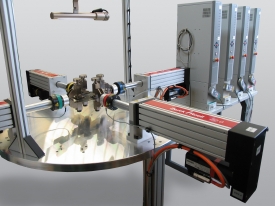Researchers at Tufts University in the US are using a Zwick biaxial testing machine to test biological and engineered biocompatible materials for the development of the world's first soft-bodied robot.

Based on the neuromechanical system of the caterpillar Manduca sexta, the softbot prototype is approximately 30 cm long and made of silicone elastomer. The mechanical material characterization is performed at the Soft Materials Characterization Laboratory at Tufts' Advanced Technology Laboratory, led by Professor Luis Dorfmann.
The Zwick Roell biaxial testing machine is being used to characterize isotropic and anisotropic elastomers and thus helps the researchers to model the behaviour of the material. "Unlike vertebrates, caterpillars don't have bones associated with their muscles to provide a system of levers," says Professor Barry Trimmer, principal investigator on the project. "Though we know lots about vertebrate muscles we don't know a whole lot about caterpillars' muscles. Yet caterpillars can crawl up walls, grasp narrow branches or stems with sticky Velcro-like feet, and rotate their bodies almost full-circle as they sense their environment."
Understanding soft materials is one of the first steps to building a robot that, like a caterpillar, couldn't be made out of traditional hard materials.
Potential applications for the innovative robots include emergency search and retrieval, medical diagnosis and treatment, manufacturing and aerospace.
Though the soft-body robot prototypes won't be made with a material that can mimic all the properties of the natural cuticle, the group is aiming to make a soft-bodied robot using a biodegradable material, such as silk. "By developing a soft, flexible material that can degrade, a soft-bodied robot made of this material could enter the body as a diagnostic tool and not need to be retrieved," says David Kaplan, co-principal investigator on the project and professor in the Department of Biomedical Engineering.
The Zwick machine is a custom built biaxial material testing system equipped with four linear independently controlled actuators of 2kN capacity. It is used to determine the constitutive functions for the in-plane response of isotropic and anisotropic materials. Each actuator is fitted with a loading fixture for applications of tensile or compressive loads to the test sample and a dedicated load cell. The actuator drive system’s travel resolution is 0.1µm, while the load cells resolution is 0.001N.
Zwick’s videoXtens extensometer, which is rigidly fixed to the machine frame, allows for non-contact strain measurements of materials that undergo medium to large deformations. The extensometer is equipped to capture both axial and transverse strains simultaneously in separate input channels. Camera lenses are interchangeable to permit different field of views and minimum theoretical resolution range from 0.3 µm to 6 µm. The testing software testXpert® II installed on a dedicated computer allows universities full customization of test procedures, loading sequences as well as standard DIN, ISO and ASTM test programs. To accommodate diverse testing protocols, custom-designed test fixtures can be designed by one of the lab engineers, and coupled with an appropriate force transducer. A water bath for characterization of materials in various solutions is also available.
"The Zwick machine has proved invaluable to us in our research," says Professor Dorfmann. "Understanding and characterization of anisotropic materials requires testing with such specialized equipment.”